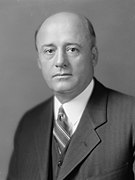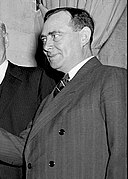| |||||||||||||||||||||||||||||||||||||
All 435 seats in the United States House of Representatives 218 seats needed for a majority | |||||||||||||||||||||||||||||||||||||
|---|---|---|---|---|---|---|---|---|---|---|---|---|---|---|---|---|---|---|---|---|---|---|---|---|---|---|---|---|---|---|---|---|---|---|---|---|---|
| |||||||||||||||||||||||||||||||||||||
 Results: Democratic hold Democratic gain Republican hold Republican gain | |||||||||||||||||||||||||||||||||||||
| |||||||||||||||||||||||||||||||||||||
The 1954 United States House of Representatives elections was an election for the United States House of Representatives to elect members to serve in the 84th United States Congress. They were held for the most part on November 2, 1954, in the middle of Dwight Eisenhower's first presidential term, while Maine held theirs on September 13. Eisenhower's Republican Party lost eighteen seats in the House, giving the Democratic Party a majority that it would retain in every House election until 1994. This was nonetheless the first occasion when a Republican won a seat from Florida since 1882,[1] and the first when the GOP won a seat from Texas since 1930.[2]
Perhaps the major reason for the Republican defeat was the backlash against the Army–McCarthy Hearings, in which prominent Republican Senator Joseph McCarthy accused countless political and intellectual figures of having communist ties, usually with no evidence. Another issue was the Dixon–Yates contract to supply power to the Atomic Energy Commission. Other factors included a comment made in Detroit by Defense Secretary Charles Wilson, former president of General Motors, equating unemployed auto workers with "lazy kennel dogs who sit... and yell."[3]
However, it has been pointed out that losses in the midterm election were considerably less than the White House party generally faces in the midterm elections, and this has been attributed to the overall popularity of President Eisenhower, who participated in the campaign along with Vice-President Richard Nixon and other members of the cabinet.[4]
Sam Rayburn of Texas became Speaker of the House, exchanging places with new Minority Leader Joseph W. Martin Jr. of Massachusetts; they went back to what they had been before the 1952 elections.
Cite error: There are <ref group=lower-alpha> tags or {{efn}} templates on this page, but the references will not show without a {{reflist|group=lower-alpha}} template or {{notelist}} template (see the help page).
- ^ Bullock, Charles S.; Rozell, Mark J. (2007). The New Politics of the Old South: An Introduction to Southern Politics. Rowman and Littlefield. p. 272. ISBN 978-0742553446.
- ^ Davis, Michelle H. (2021). Dixiegops: The Untold Story of the Dixiecrat-Republican Coalition. Independently Published. p. 106. ISBN 9798546782238.
- ^ Ambrose, Stephen (1991). Eisenhower: Soldier and President. Simon and Schuster. p. 375. ISBN 9780671747589.
- ^ Ambrose, Stephen (1991). Eisenhower: Soldier and President. Simon and Schuster. p. 375. ISBN 9780671747589.


